
A History of the Pine River Watershed
NOTE: If you wish to see documents related to this timeline, go to the Documents setion under Resources. The documents are listed in chronological order.
The Pine River watershed in northern Gratiot County Michigan has been an environmentally stressed community for more than a century, experiencing cycles of both growth and decline as a result of resource exploitation. In the first generation of European settlement, the region was deforested, accompanied by significant erosion and wild fires.. As the forests were being depleted, the region tried to capitalize on mineral springs in the lower valley to create a resort center at St. Louis. Soon the brine beneath the ground was tapped for more lucrative if less environmentally friendly uses (involving chemical processing), which undermined the area’s potential as a vacation site.
Brine extraction promoted the growth of the chemical industry, symbolized best by the opening in 1935 of Michigan Chemical Company (later Velsicol Chemical) in St. Louis. At the same time, oil extraction around the region promoted the growth of several small refineries in Alma and St. Louis, one of which survived until the end of the 20th Century as the Total Petroleum refinery in Alma. As with forestry, however, extraction of resources was both so complete and so reckless that first the chemical plant (1978) and then the last refinery (1999) shut down.
At the time of each of these changes, the region experienced economic and social shocks due to environmental exploitation. The region’s first settlers, the Saginaw Chippewa Indian Tribe lost most of their land, although retaining fishing rights on the river under the Treaty of the Saginaw, September 24, 1819 (7 Stat. 203). However, even those rights have been made meaningless by a complete ban on eating the contaminated fish from imposed on the river by state health officials in 1974. The owners and employees of the timber companies and then the tourist industry lost their assets as a result of later changes. Then in the 1970’s the closure of Velsicol Chemical deprived over 400 union members in St. Louis (population 4000) of their jobs. Beginning about the same time, Total Petroleum began a significant cut back in employment in Alma, associated with mergers in the oil industry and resource depletion. Headquarters moved from Alma to Denver in 1980. In the mid-1990’s the other office operations of Total moved to San Antonio. In 1999, the last 250 refinery workers lost their jobs.
The Task Force was incorporated in 1998 and has worked since then to restore the region’s environment and assist in assessing and developing clinical responses to health problems related to the contamination. Below, we have a long list of years in which significant events in this story took place, often with links (in blue) to documents and images related to particular events. The timeline is long and it begins with the early inhabitants of the community.
1819
The Treaty of Saginaw is signed between the leaders of the Chippewa peoples and Territorial Governor Lewis Cass, representing the U. S. Government. Under the treaty, in exchange for giving up land in the region for settlement, the Chippewa retain fishing rights in the river. The treaty was not broken until the 1930s
1858
St. Louis Incorporated
1929
Oil discovered in region
1931
Velsicol Chemical founded in Chicago by Joseph Regenstein
1934
Midwest Refinery opens in Alma on Pine River
1935
Michigan Chemical incorporated; producing ethyl bromine for petroleum refiners and other chemicals for road dust control and the pharmaceutical industry & salt for both human and animal use McClanahan Refinery opens on south end what is of later Velsicol plant site Saginaw City Council unanimously calls on state to protect Pine River Research team from University of Michigan documents water pollution problems of the Pine River
1937
Study published in Journal of Industrial Hygiene and Toxicology warning of health danger of compounds such as DDT
1939
Leonard Refinery purchases and moves McClanahan to Alma, Michigan Chemical acquires the McClanahan property
1941
121 St. Louis Citizens file complaints about Michigan Chemical contamination
1944
Michigan Chemical begins DDT production for use by military to protect troops and refugees from malaria during World War II
1945
The New Yorker publishes a story warning of the dangers of DDT use. When war ends, Michigan Chemical sells DDT to United Nations Relief and Rehabilitation Administration for dusting refugees to protect from malaria; also full production of magnesium oxide animal feed supplement begun.
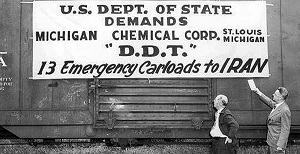
1946
The New Republic publishes a story warning of the problem of resistance developing from mass use of DDT
1947
The New York Times Magazine runs story about the growing DDT resistance problem; Michigan Chemical begins flame retardant production
1948
Nobel Prize for Physiology awarded to Paul Müller for discovery of DDT use against arthropods
1954
George Wallace, Michigan State University ornithologist begins DDT studies
1955
Michigan Department of Natural Resources in “A Biological Survey of the Pine River” documents extensive DDT contamination linked to Michigan Chemical; Midwest Refinery along Pine River purchased by Leonard Refinery; rare earth production begins (and disposal of low-level radioactive wastes from that process)
1957
Michigan DNR issues another negative report on the Pine River
1958
DDT production ends
1960
George Wallace testifies about DDT poisoning before the U.S. House Subcommittee on Fisheries and Wildlife; threatened with termination by Michigan State, defended by Michigan Congressman John Dingell
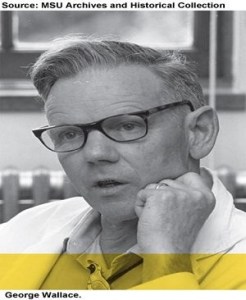
George Wallace, the ornithologist
1962
Rachel Carson completes Silent Spring; Velsicol threatens a law suit against the publisher; American Medical Association and the American Chemical Society join in attacking Rachel Carson’s ‘hysteria’
1964
Velsicol owned 50.5% of Michigan Chemical
1965
Velsicol completes purchase of Michigan Chemical and then is acquired by the Chicago and North Western Railway.
1966
Velsicol pays for publication of That We May Live attacking Rachel Carson
1967
Michigan DNR issues another negative report on Pine River, followed up in 1970
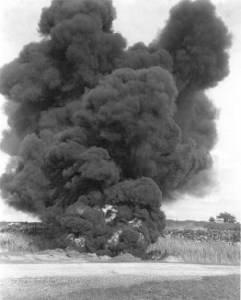
Chemical disposal by Molotov cocktail in the Gratiot Golf Course
1968
Chicago and North Western Railway buys the Reading Railroad (as in the Monopoly game) which owned Fruit of the Loom underwear. The firm changes its name to Northwest Industries but keeps the Michigan Chemical name on the old Michigan Chemical plants.
1971
Michigan Chemical begins full production of flame retardants based on PBB
The Accident and a Response (1973-1997)
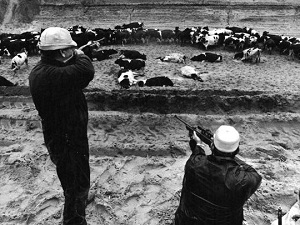
Shooting cows in mid-1970s after contamination with PBB
1973
PBB accident; Michigan Chemical ships one or more truckloads of PBB in place of Mag-Oxide to Farm Bureau Services feed supply facility in Climax, Michigan
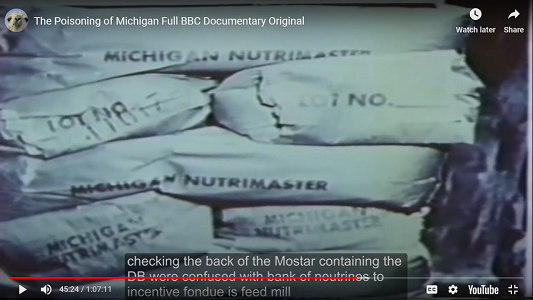
Poorly stored bags of Nutrimaster and Firemaster in Michigan Chemical warehouse.
1974
Contamination of farm animals with PBB discovered and Michigan Chemical identified as source; quarantine of some farms begins and first cattle euthanized and buried in Kalkaska; Dr. Tom Corbett begins research on PBB in farm products and Dr. Irving Selikoff begins work on PBB in humans; Breckenridge cancer cluster studies begin
1975
Dr. Alpha Clark McBain, MI confirms PBB causing animal health problems.
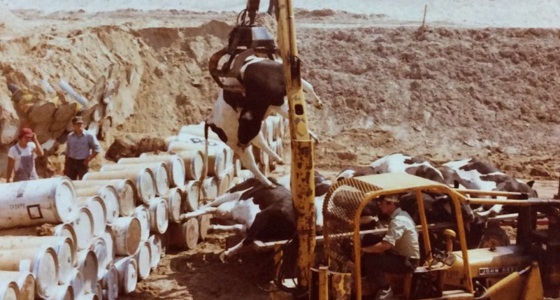
Burying bodies of PBB contaminated cows.
1976
Michigan PBB Registry established by Michigan Department of Public Health (later MDCH and
MDHHS) to track at least 4,000 exposed people; Michigan files a lawsuit against Velsicol
1977
Thames Television (British) runs documentary “The Poisoning of Michigan”
1978
Velsicol closes Michigan Chemical plant in St. Louis and begins negotiations with US EPA and Michigan Department of Natural Resources on settlement; CBS delays showing “Slaughter,” TV dramatization of PBB accident, until after elections so as not to influence outcome
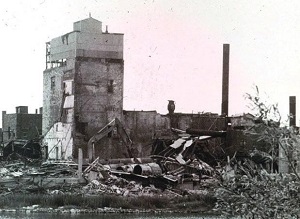
Demolition of the Michigan Chemical-Velsicol plant about 1980; to be buried on the old plant site.
1980
Superfund (CERCLA) passed by Congress
1981
Bitter Harvest film opens about the PBB accident
1982
The Consent Judgment is signed between Velsicol and federal and state officials
1983
Former Velsicol plant site, Gratiot County Landfill and Velsicol Burn Pit – called the Gratiot Golf Course site) become Superfund sites (except, Velsicol promises to remove contamination at burn pit so it is delisted from National Priorities List (NPL); Michigan DNR begins fish sampling in river, followed up in 1985, 1989, and 1994 and 1995, showing increasing DDT uptake
1984
Burial of old plant completed and St. Louis sites become ‘dormant,’ with tombstone warning of chemical and radioactive dangers of old plant site; Bill Farley buys Northwest Industries with borrowed money, renames it Fruit of the Loom and ‘sells’ Velsicol to managers, who refuse to take possession of firm’s seven sites, locations of worst pollution, including three Michigan sites: the old plant site, the burn pit, and the Breckenridge radioactive waste site
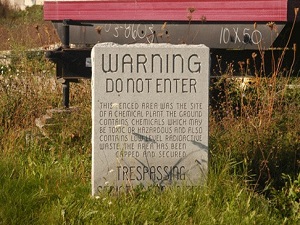
Labeling St. Louis forever as a contaminated town.
1988
ATSDR preliminary report warns of fish contamination and human health exposures
1991
Former workers settle lawsuit with Velsicol out-of-court; USEPA requests help from US Army Corps of Engineers to study DDT in river
1992
First Alma College assessment of policy failure published and shared with USEPA
1993
ATSDR reports critically on functioning of Velsicol’s containment of contamination at plant site and notes river fish have unacceptable DDT levels; longer Alma College policy assessment published and shared with US EPA
1994
Michigan DNR fish sampling reveals doubling of DDT levels since 1989
1996
Michigan Department of Environmental Quality (former DNR) staff report on fish contamination in impoundment after 1994 and 1995 sampling
1997
U.S. EPA holds public meeting in St. Louis to announce problems with river
THE TASK FORCE ERA (1998-present)
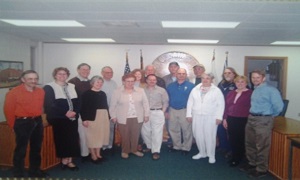
Group picture of Task Force founders 1998
YEAR/EVENT(s)
1998
Task Force formed; US EPA begins planning emergency removal action in river; Velsicol buys $100 million environmental insurance from AIG; Fruit of the Loom buys another $100 million
1999
Emergency removal action begins; Total Petroleum closes; Task Force applies for grant from NIEHS to study infant exposures; Fruit of the Loom files for bankruptcy
2000
Task Force files claim against Fruit of the Loom in bankruptcy court for $100 million; Task Force demands Justice Department public meeting on Total ettlement and receives $13 million Supplemental Environmental Project for clean-up of Horse Creek and other projects; EPA begins planning larger removal of river sediment
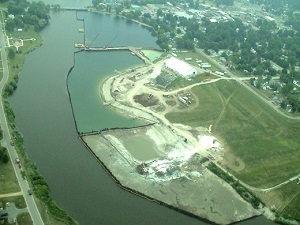
Removal of sediments expands
2001
Task Force files second human health grant proposal with NIEHS; after rejection, CAG demands CDC respond to local needs (see 2005)
2002
Task Force secures legal help from University of Michigan School of Law in bankruptcy claim; law students win Task Force help with natural resource damage claim filed by National Oceanic and Atmospheric Administration; gets Justice Department to hold public hearing in St. Louis on Fruit of the Loom settlement; Task Forcee invited community leaders from near the Memphis, Tennessee velsicol factory to join our hearing; our counterparts from Memphis eventually forced DOJ to hold a second hearing there; Fruit of the Loom settles for $42.5 million for remediation of seven sites nationally, but including the Breckenridge site and the plant site in St. Louis; trust established through the US Dept. of Justice to ‘own’ sites and work on remediation with US EPA; migration of contaminants in the form of Non-aqueous Phase Liquids (NAPL) and Dense Non-Aqueous Phase Liquids (DNAPL) from the plant site toward the river verified
2004
Horse Creek remediation under Total supplemental environmental project finished
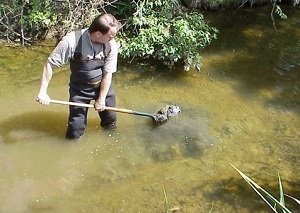
Murray Borrello sampling Horse Creek sludge
2005
para-Chorobenzinesulfonic acid (pCBSA) found in St. Louis drinking water, a DDT by-product; Task Force compels ATSDR and CDC to participate in community health conference at Alma College; Task Force files and wins bankruptcy claim against Oxford Automotive for hexavalent chromium dumping; Wall Street Journal runs story defending DDT, publicizing petro-chemical industry lobbying for DDT and using Rachel Carson as symbol of over-regulation

2006
St. Louis sues to overturn bankruptcy settlement and recover funds for a new water system
2007
USEPA stated that the 1982 containment system for the plant site had failed and they were beginning a formal process of determining a remedy' we helped host speech at Alma College by Robert Bullard on environmentl justice
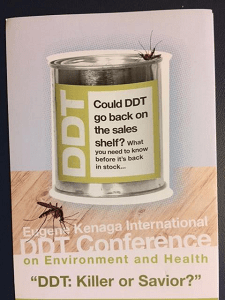
Recruiting for DDT Conference 2007-2008
2008
U.S. Department of Justice sides with Fruit of the Loom and Velsicol vs. St. Louis water system lawsuit; Task Force and Alma College host Eugene Kenaga International DDT Conference
2009
Pine River Statement on DDT published; discussed at Stockholm Convention meeting
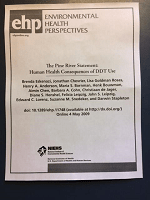
Pine River Statement
2010
Velsicol Burn Pit returned to Superfund National Priorities List (NPL – it had been delisted in 1983 after Velsicol claimed it had brought all contamination to the plant site for burial
2011
St. Louis won lawsuit for new water system
2012
USEPA holds public hearing and finalizes Record of Decision to plan remediation of Velsicol plant site; initial contact made with Emory University PBB team; clean-up at Breckenridge site concluded; remediation began of hot spots in the neighborhoods near the plant site -the Adjacent and Neighboring Properties (ANP)
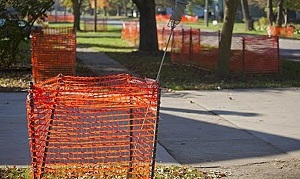
Red fences around hot spots across 9 block area
2013
Task Force hosts with Emory University first joint PBB health screenings; launched new dead bird egg/nest study
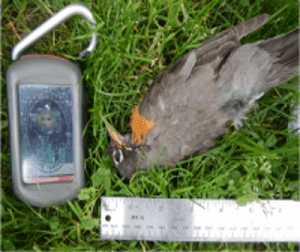
Testing dead birds
2015
New water system comes on-line for St. Louis with Gratiot Water Authority; St. Louis High School athletic field emergency clean-up and residential soils clean-up completed
2016
“Birds Falling from Sky” articles appear in press about St. Louis contamination; Task Force hosts with Emory University and Alma College, Intergenerational Risk Conference; complete remediation of residential soil contamination in 12 blocks adjacent to old plant site
2018
Thermal treatment of wastes on old plant site begin; PBB Oral History Project funded; PBB screenings held in Fremont and Cadillac
2019
US EPA begins study of flood plain remediation; EPA completes first phase of thermal treatment at the plant site and finishes installation of second phase thermal treatment electrodes; PBB screenings held in Bad Axe, Fremont, and Lansing; new sampling for DDT at high school fields found some high spots; PBB to PFAS orientation held for legislators in Lansing.
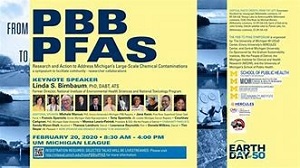
2020
Conference held at University of Michigan From PBB to PFAS; Phase two thermal treatment begins; NAPL collection during Phase II much larger than anticipated; Task Force requests formal evaluation of why unanticipated NAPL at site.
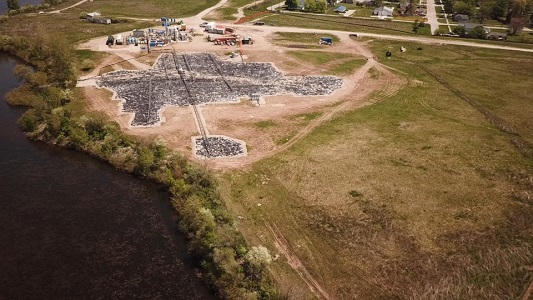
Field of electrodes to boil-off contaminants under old plant site cap.
2022
Remediation continued in former plant siteand expandedto the south end of the site. Also, plans announcd to add a new 'operable' unit downriver from the St. Louis Dam in the flood plain. Also remediation at the old burn pit across the river from the plant site moved closer to remediation.
2023
From May 18 to 20, 2023 a coalition of groups and institutions hosted a Conference focused on the 50th Anniversery of the PBB accident (May 1973 was the time of the mistaken shipment of the fire retardant made of PBB to an animal feed supply facility near Bttle Creek, contaminating the food chain in the state of Michigan). See the special Conference heading for more information,